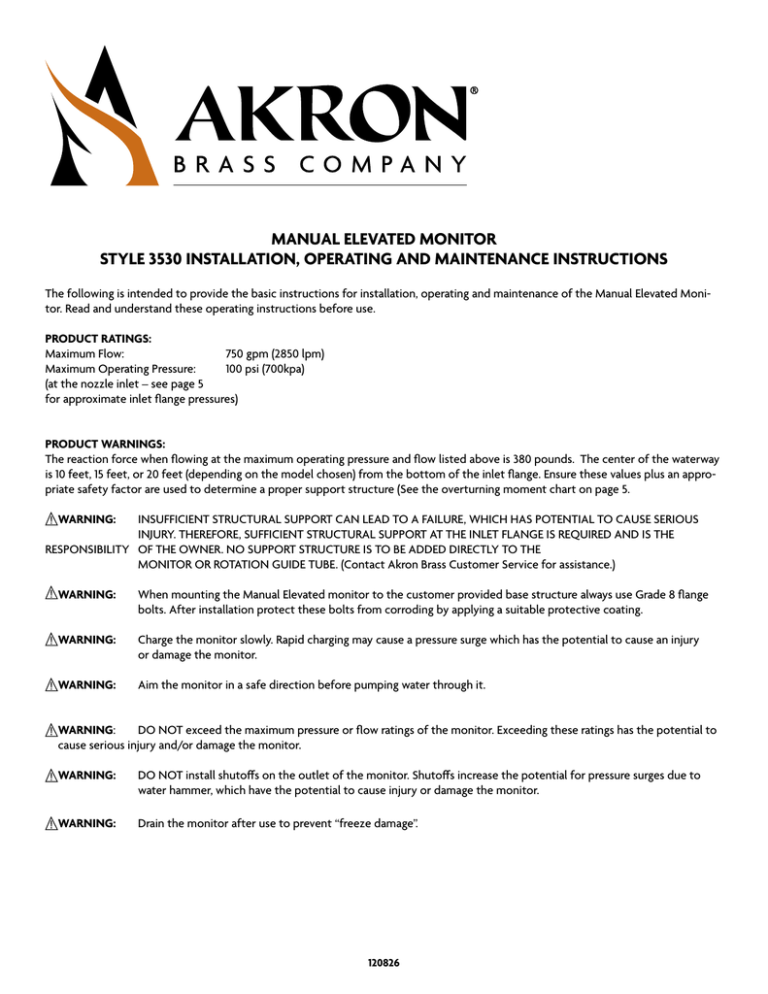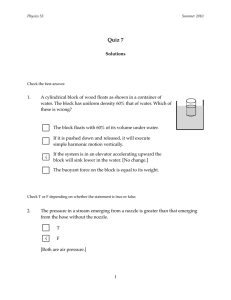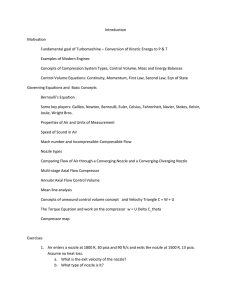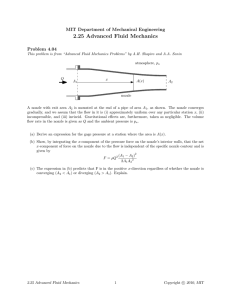
MANUAL ELEVATED MONITOR
STYLE 3530 INSTALLATION, OPERATING AND MAINTENANCE INSTRUCTIONS
The following is intended to provide the basic instructions for installation, operating and maintenance of the Manual Elevated Monitor. Read and understand these operating instructions before use.
PRODUCT RATINGS:
Maximum Flow:
750 gpm (2850 lpm)
Maximum Operating Pressure:
100 psi (700kpa)
(at the nozzle inlet – see page 5
for approximate inlet flange pressures)
PRODUCT WARNINGS:
The reaction force when flowing at the maximum operating pressure and flow listed above is 380 pounds. The center of the waterway
is 10 feet, 15 feet, or 20 feet (depending on the model chosen) from the bottom of the inlet flange. Ensure these values plus an appropriate safety factor are used to determine a proper support structure (See the overturning moment chart on page 5.
WARNING:
INSUFFICIENT STRUCTURAL SUPPORT CAN LEAD TO A FAILURE, WHICH HAS POTENTIAL TO CAUSE SERIOUS INJURY. THEREFORE, SUFFICIENT STRUCTURAL SUPPORT AT THE INLET FLANGE IS REQUIRED AND IS THE RESPONSIBILITY OF THE OWNER. NO SUPPORT STRUCTURE IS TO BE ADDED DIRECTLY TO THE
MONITOR OR ROTATION GUIDE TUBE. (Contact Akron Brass Customer Service for assistance.)
WARNING:
When mounting the Manual Elevated monitor to the customer provided base structure always use Grade 8 flange bolts. After installation protect these bolts from corroding by applying a suitable protective coating.
WARNING: Charge the monitor slowly. Rapid charging may cause a pressure surge which has the potential to cause an injury or damage the monitor.
WARNING: Aim the monitor in a safe direction before pumping water through it.
WARNING: DO NOT exceed the maximum pressure or flow ratings of the monitor. Exceeding these ratings has the potential to cause serious injury and/or damage the monitor.
WARNING: DO NOT install shutoffs on the outlet of the monitor. Shutoffs increase the potential for pressure surges due to water hammer, which have the potential to cause injury or damage the monitor.
WARNING: Drain the monitor after use to prevent “freeze damage”.
120826
CAUTIONS:
Your monitor and nozzle should be inspected prior to and after each use to ensure it is in good
operating condition. Potentially, an unanticipated incident may occur where the unit is used in a manner that is inconsistent with standard operating practices. A partial list of potential misuses includes:
• Operating above maximum rated pressure or flow.
• Not draining and allowing water to freeze in the unit.
• Prolonged exposure to temperatures above 140 degrees F, or below -40 degrees F.
• Operating in a extremely corrosive environment.
• Other misuse that may be unique to your specific environment.
Also, there are many “tell tale” signs that indicate repair is in order, such as:
• A handle, knob or cable that is inoperable or difficult to operate.
• Excessive wear.
• Poor discharge performance.
• Water leaks.
If any of the above situations are encountered, the monitor should be taken out of service, repaired and tested by a qualified technician before placing it back in service.
PACKAGING:
Each Elevated Manual Monitor is shipped unassembled. There is one long wood crate containing the Flanged Waterway and the Rotation Drive Tube and a cardboard carton containing the Monitor, Nozzle, Handle Assembly, Cables and a Hardware Package.
FIELD ASSEMBLY:
Refer to the enclosed assembly drawing located on the back page of these instructions while completing field assembly.
Step 1 - Remove all items from the wooden crate and cardboard carton.
Step 2 – Ensure that the Rotation Drive Tube (Item 1) is installed over the Flanged Waterway (Item 2) as it was originally shipped
in the wooden crate.
Step 3 – Attach the Monitor Assembly (Item 3) to the Flanged Waterway (Item 2) via the 3” NPT connection. Use a suitable pipe
sealing compound on this connection.
Step 4 – Attach the Rotation Drive Tube (Item 1) to the Monitor Assembly (Item 3) with the (2) Cap Screws (Item 4) and Spacer (Item 5) located in the Hardware Kit.
Note: Align the Handle Bracket located near the bottom of the Rotational Drive Tube (Item 1) with the outlet of the Monitor Assembly (Item 3) as shown on the assembly drawing before installing these cap screws.
Step 5 – Attach the Handle Assembly (Item 6) to the Rotation Drive Tube (Item 1) using the (4) 3/8 Cap Screws (Item 7) use a thread locking compound such as Loctite 222 or Permabond LM113 on these cap screws.
Step 6 – Attach the Elevation Control Cables (Item 9) to the Elevation Control Arm (Item 10) located on the side of the Monitor Assembly (Item 3) using the “D” Rings (Item 11) located in the Hardware Kit as shown on the assembly drawing.
Step 7 – Attach the Turnbuckles (Item 12) to the Handle Assembly (Item 6) using the (2) Cap Screws (Item 13) and Spacers
(Item 14) from the Hardware Kit as shown on the assembly drawing. Step 8 – Attach the other ends of the Elevation Control Cables (Item 9) to the Turnbuckles as shown on the assembly drawing.
Step 9 – Adjust the Turnbuckles (Item 12) so that the Handle Assembly (Item 6) and outlet of the monitor (Item 3) are parallel.
Step 10 – Attach either the Nozzle (Item 15) or Tip and Discharge Tube (Item 15) - which ever was purchased with the Manual
Elevated Monitor - to the Monitor Assembly (Item 3) via the 2 ½ “ NH connection. If a Tip and Discharge Tube was
purchased, skip to Step 14.
2
Step 11 - Align the bracket on the nozzle as shown on the assembly drawing. Ensure that this is a tight connection by using a suitable spanner wrench.
Note:
After final assembly and installation, the nozzle body must not rotate when the cables are
activated to change the water stream pattern. NOTE: The nozzle pattern sleeve should rotate.
Step 12 – Attach one end of the Pattern Control Cable (Item 16) to one end of the permanently attached cable located on the nozzle pattern sleeve using the “D” Ring (Item 17) located in the
Hardware Kit as shown on the assembly drawing.
Step 13 – Thread the other end of the Pattern Control Cable (Item 16) through the Eye Bolt (Item 18) located on the Handle Assembly (Item 6) and connect it to the other permanently attached cable located on the nozzle pattern sleeve using the “D” (Item 17) located in the Hardware Kit as shown on the assembly drawing.
Step 14 – Install the Rotation Lock Knob (Item 19) and the Set Screw (Item 20) into the Rotation Drive Tube (Item 1) as shown on the assembly drawing. Use a thread locking compound such as Loctite 222 or Permabond LM113 on the set screw. After the set screw is tightened, loosen ½ turn and ensure that the Rotation Lock Knob operates freely.
Step 15 – Using a suitable lifting apparatus - stand the completed assembly upright and attach to the customer provided base struc
ure. Be sure to use a suitable gasket between the flanges. Use the lifting points as shown on the assembly drawing. DO NOT ATTACH ANY LIFTING STRAP, CHAIN, ETC. TO THE MONITOR OUTLET AS SERIOUS DAMAGE TO THE MONITOR MAY OCCUR.
Warning - When mounting the Manual Elevated monitor to the customer provided base structure always use Grade 8 flange bolts. After installation protect these bolts from corroding by applying a suitable protective coating.
OPERATING INSTRUCTIONS:
The Handle Assembly controls the rotation and elevation functions of the Manual Elevated Monitor. The Handle assembly also acts
as a brake for the Elevation function. There is a Rotation Brake knob located on the Drive Tube near the Handle Assembly to lock the
rotation function.
To change the horizontal position of the Manual Elevated Monitor:
1. Loosen the Rotational Lock Knob.
2. Move the Handle Assembly until the Manual Elevated Monitor is pointed in the desired direction.
3. Tighten the Rotational Lock Knob.
To change the vertical position of the Manual Elevated Monitor:
1. Loosen the Elevation Lock Knob which is part of the Handle Assembly.
2. Move the Handle Assembly until the Manual Elevated Monitor is pointed in the desired direction.
3. Tighten the Elevation Lock Knob.
NOTE: The nozzle should always be stored in a downward position.
3
To change the nozzle Stream/Pattern function of the Manual Elevated Monitor:
There is a cable that is attached to the pattern sleeve of the nozzle. Pulling on either side of this cable changes the nozzle pattern Fog or Straight Stream.
When standing behind the Manual Elevated Monitor i.e. the outlet of the monitor is pointed away from you:
• Pulling on the cable (left side) moves the nozzle to the Fog setting.
• Pulling on the cable (right side) moves the nozzle to the Stream setting.
MAINTENANCE INSTRUCTIONS:
• Periodically lubricate the grease fittings on the Monitor and nozzle with Lubriplate
Low-Temp lubricant or equivalent.
• Inject the lubricant until it becomes visible from the bleeder holes in the center of the swivel plugs of the monitor or through the bleed hole on the nozzle.
• Periodically clean grit and dirt from around exterior moving parts.
• Periodically operate all functions of the monitor through its full travel.
• The brake mechanism on the horizontal and vertical travel may require periodic stops. Turning the brake knob clockwise should lock the monitor. If the monitor does not lock, remove the lock mechanism, inspect for wear and replace components as necessary.
• Replace the identification tag if it is worn or damaged.
DATA FOR FOUNDATION DESIGN
WARNING: INSUFFICIENT STRUCTURAL SUPPORT CAN LEAD TO A FAILURE, WHICH HAS
POTENTIAL TO CAUSE SERIOUS INJURY. THEREFORE, SUFFICIENT STRUCTURAL SUPPORT AT THE INLET FLANGE IS REQUIRED AND
IS THE RESPONSIBILITY OF THE OWNER NO SUPPORT STRUCTURE IS TO BE ADDED DIRECTLY TO THE MONITOR OR ROTATION
GUIDE TUBE.
4
Manual Elevated Monitor Height
Manual Elevated Monitor
Weight
O.T Moment at Recommended Maximum
Pressure (100 psi) and Flow (750 gpm)
10 Foot
270 lbs.
3,800 ft-lbs.
15 Foot
350 lbs.
5,700 ft-lbs.
20 Foot
425 lbs.
7,600 ft-lbs.
APPROXIMATE PRESSURE REQUIRED AT THE INLET FLANGE TO THE MANUAL ELEVATED MONITOR TO ACHIEVE 100 PSI AT THE
NOZZLE INLET.
Manual Elevated Monitor Height
Nozzle set to 300
gpm
Nozzle set to 500
gpm
Nozzle set to 750
gpm
10 Foot
106 psi
110 psi
114 psi
15 Foot
109 psi
113 psi
117 psi
20 Foot
111 psi
115 psi
119 psi
Figure 1
15
10
15
11
3
4
17
5
1
12
9
16
13
19
18
7
14
20
Handle Bracket
6
2
5
This document and the information hereon are
confidential and are the EXCLUSIVE PROPERTY
of the Akron Brass Company, Wooster, Ohio.
It is provided by Akron Brass to its customers as
a design aid when incorporating Akron Brass products
into their equipment or facilities. It may only be reproduced
for that purpose. This note supersedes any similar notes
in the title block of this drawing,
88-3/16
148-3/16
208-3/16
118-11/16
178-11/16
238-11/16
120-11/16
180-11/16
240-11/16
26-3/4
20
10'
15'
20'
"X"
30-1/2
"Y"
"Z"
"X"
"Y"
"Z"
24-7/8
31-7/8
Figure 2
PHONE: 330.264.5678 or 800.228.1161 I FAX: 330.264.2944 or 800.531.7335 I akronbrass.com
revised: 4/14
WARRANTY AND DISCLAIMER: We warrant Akron Brass products for a period of five (5) years after purchase against defects in materials or workmanship. Akron Brass will repair or replace product
which fails to satisfy this warranty. Repair or replacement shall be at the discretion of Akron Brass. Products must be promptly returned to Akron Brass for warranty service.
We will not be responsible for: wear and tear; any improper installation, use, maintenance or storage; negligence of the owner or user; repair or modification after delivery; damage; failure to follow
our instructions or recommendations; or anything else beyond our control. WE MAKE NO WARRANTIES, EXPRESS OR IMPLIED, OTHER THAN THOSE INCLUDED IN THIS WARRANTY STATEMENT,
AND WE DISCLAIM ANY IMPLIED WARRANTY OF MERCHANTABILITY OR FITNESS FOR ANY PARTICULAR PURPOSE. Further, we will not be responsible for any consequential, incidental or
indirect damages (including, but not limited to, any loss of profits) from any cause whatsoever. No person has authority to change this warranty.
ISO 9001 REGISTERED COMPANY
© Akron Brass Company. 2014 All rights reserved. No portion of this can be reproduced without the express written consent of Akron Brass Company.





